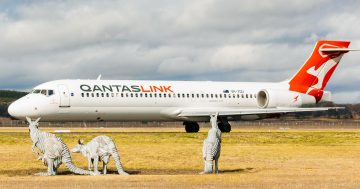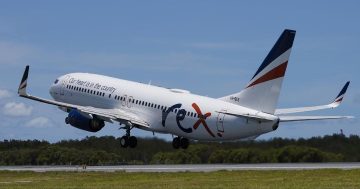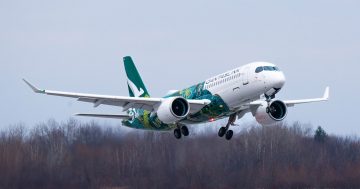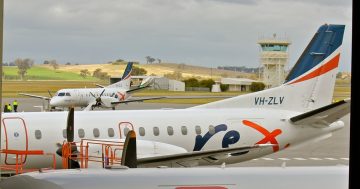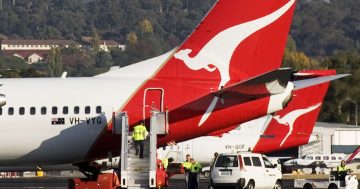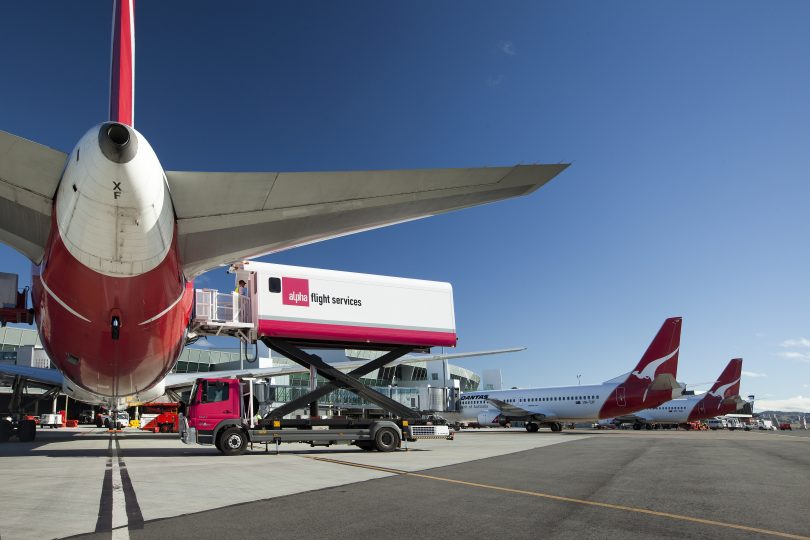
Qantas cancelled fewer flights out of Canberra in November but the percentage of on-time arrivals and departures plummeted. Photo: Canberra Airport.
Travellers through Canberra Airport may have endured fewer flight cancellations last month than they did in October but when it came to on-time arrivals and departures, the major airlines’ performances deteriorated.
The latest Bureau of Infrastructure and Transport Research Economics On Time Performance report confirms the continuing poor service provision of the major airlines across the nation, revealing the lowest average on-time statistics in more than a year for all flights.
Across all airlines, last month’s average on-time arrivals figure of 64.1 per cent was significantly lower than the long-term average performance of 81.1 per cent across all routes.
The on-time departures figure of 65.9 per cent was also significantly lower than the long-term average of 82.3 per cent.
Cancellations were at 3.7 per cent for the month, hardly moving from October’s 3.8 per cent and well above the long-term average of 2.2 per cent. However, it was an improvement on the 2022 figure of 4.4 per cent.
Virgin Australia was the worst performer for the month, with only 54.3 per cent of flights arriving on time, while 66.3 per cent of Qantas flights landed on schedule.
Virgin also had the highest percentage of cancellations at 6.3 per cent.
The smaller airlines of Bonza and Rex were the best performers, with 73.9 per cent and 70.5 per cent respectively.
At Canberra Airport, the 75 per cent on-time rate for arrivals and departures for all airlines plunged to 66.1 per cent and 65.1 per cent respectively, for services to and from Adelaide, Brisbane, Gold Coast, Melbourne and Sydney.
Jetstar was the worst performer at 62.2 and 57.5 per cent, down from 66.7 and 59.5 percent in October.
Virgin Australia was the next worst at 61.5 and 63.5 per cent, plummeting from 74.9 and 77.8 per cent.
Similarly, QantasLink dived from 77.3 and 76.4 per cent to 68.4 and 65.8 per cent.
In November there were also Qantas-branded flights, recording 86.4 and 90 per cent.
Rex managed 73.3 and 76.7 per cent of flights arriving and departing on time.
The number of cancellations fell in November on specific routes but there was no overall number for Canberra Airport.
Both the major routes of Canberra-Sydney (down from 8.2 per cent to 4.2 per cent) and Canberra-Melbourne (5.3 per cent to 2.1 per cent) suffered fewer cancellations, thanks mainly to Qantas.
QantasLink improved from a double-digit percentage (10.8 per cent) on the Canberra-Sydney route in October to less than half that (4 per cent) last month, while on the Canberra-Melbourne route, it slashed cancellations from 8 per cent to 2.4 per cent.
But it also scheduled and flew fewer flights on both routes than it did in October, using bigger aircraft.
Virgin was not so efficient, increasing its cancellations on the Canberra-Sydney route from 4.3 per cent to 4.8 per cent, and on the Melbourne route from 1.6 per cent to 2.4 per cent.
There was a marginal improvement on the Canberra-Brisbane route, from 2.6 per cent to 2.3 per cent.
Jetstar was steady at 3.3 and 3.2 per cent, while QantasLink cancellations fell from 1.1 per cent to 0.6. per cent.
Nationally, on-time performance over all routes averaged 64.1 per cent for arrivals and 65.9 per cent for departures, worse than in November 2022, when it was 66.2 and 66.5 per cent respectively.
Both the arrivals and departure figures were significantly lower than the long-term average performance for all routes (81.1 per cent and 82.3 per cent).
Virgin Australia’s cancellation figure of 6.3 per cent was followed by Skytrans at 4.7 per cent, Bonza at 4.2 per cent, Virgin Australia Regional Airlines at 3.6 per cent, Qantas and QantasLink at 3.3 per cent, Jetstar at 2.7 per cent and Rex Airlines at 0.9 per cent.
Federal Transport Minister Catherine King used the report to put the major airlines on notice, saying it was no wonder that so many Australians were fed up with them.
“Like all Australians, the government wants an aviation sector that supports our nation’s way of life and this means services need to be reliable, competitive and affordable,” she said.
“That’s why we have committed to delivering an Aviation White Paper, expected to be released in mid-2024, to set the scene for the next generation of growth and development across the aviation sector.
“This will include consideration of how we can better protect the interests of consumers, whether that be a stronger ombudsman model or other measures implemented in overseas jurisdictions.”












